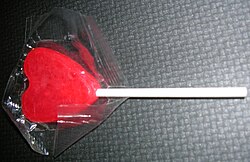| Revision as of 00:35, 7 July 2009 view sourceA little insignificant (talk | contribs)Pending changes reviewers, Rollbackers9,444 edits →History: Removed OR← Previous edit | Revision as of 02:33, 7 July 2009 view source Soap (talk | contribs)Extended confirmed users, Rollbackers29,118 edits Undid revision 300702783 by A little insignificant (talk); the source is at the end of the following sentenceNext edit → | ||
| Line 30: | Line 30: | ||
| </ref> Flavored lollipops made with children's medicine have also been created in order to effectively give kids medicine without fuss. Drugmakers have also developed lollipops containing fentanyl, a powerful analgesic. | </ref> Flavored lollipops made with children's medicine have also been created in order to effectively give kids medicine without fuss. Drugmakers have also developed lollipops containing fentanyl, a powerful analgesic. | ||
| == History == | == History == | ||
| The idea of an edible candy on a stick is very simple, and it is probable that the lollipop has been invented and reinvented numerous times.<ref name=lolly></ref> The word "lolly pop" dates to 1784, but initially referred to soft, rather than hard candy. The first references to the lollipop in its modern context date to the 1920s.<ref></ref> Alternatively it may be a word of Romany origin being related to the Roma tradition of selling ] sold on a stick. ''Red apple'' in the ] is ''loli phaba''.<ref name=googlebooks></ref> | The idea of an edible candy on a stick is very simple, and it is probable that the lollipop has been invented and reinvented numerous times.<ref name=lolly></ref> The word "lolly pop" dates to 1784, but initially referred to soft, rather than hard candy. The term may have derived from the term "lolly" (tongue) and "pop" (slap). The first references to the lollipop in its modern context date to the 1920s.<ref></ref> Alternatively it may be a word of Romany origin being related to the Roma tradition of selling ] sold on a stick. ''Red apple'' in the ] is ''loli phaba''.<ref name=googlebooks></ref> | ||
| The first confectioneries that closely resemble what we call lollipops date to the ], when the nobility would often eat boiled sugar with the aid of sticks or handles.<ref name=lolly/> The invention of the modern lollipop is still something of a mystery but a number of American companies in the early 20th century have laid claim to it. | The first confectioneries that closely resemble what we call lollipops date to the ], when the nobility would often eat boiled sugar with the aid of sticks or handles.<ref name=lolly/> The invention of the modern lollipop is still something of a mystery but a number of American companies in the early 20th century have laid claim to it. | ||
Revision as of 02:33, 7 July 2009
For other uses, see Lollipop (disambiguation).


A lollipop, pop, lolly, sucker, or sticky-pop is a type of confectionery consisting mainly of hardened, flavored sucrose with corn syrup mounted on a stick and intended for sucking or licking. They are available in many flavors and shapes.
Types
Lollipops are available in a number of colors and flavors, particularly fruit flavors. In the Nordic countries, Germany and the Netherlands, salmiak-flavored lollipops are also available, but these are largely unknown in other parts of the world. With numerous companies producing lollipops, the candy now comes in dozens of flavors and many different shapes. They range from small ones which can be bought by the hundred and are often given away for free at banks, barbershops, etc., to very large ones made out of candy canes twisted into a circle.
Some lollipops contain fillings, such as bubble gum or soft candy. Some novelty lollipops have more unusual items, such as mealworm larvae, embedded in the candy. Other novelty lollipops have non-edible centers, such a flashing light, embedded within the candy; there is also a trend of lollipops with sticks attached to a motorized device that makes the entire lollipop spin around in one's mouth.
Some lollipops have been marketed for use as diet aids, although their effectiveness is untested, and anecdotal cases of weight loss may be due to the power of suggestion. Flavored lollipops made with children's medicine have also been created in order to effectively give kids medicine without fuss. Drugmakers have also developed lollipops containing fentanyl, a powerful analgesic.
History
The idea of an edible candy on a stick is very simple, and it is probable that the lollipop has been invented and reinvented numerous times. The word "lolly pop" dates to 1784, but initially referred to soft, rather than hard candy. The term may have derived from the term "lolly" (tongue) and "pop" (slap). The first references to the lollipop in its modern context date to the 1920s. Alternatively it may be a word of Romany origin being related to the Roma tradition of selling toffee apples sold on a stick. Red apple in the Romany language is loli phaba.
The first confectioneries that closely resemble what we call lollipops date to the Middle Ages, when the nobility would often eat boiled sugar with the aid of sticks or handles. The invention of the modern lollipop is still something of a mystery but a number of American companies in the early 20th century have laid claim to it.
See also
References
- "Lollipop". How Products are Made. Advameg Inc. 2007. Retrieved 2007-08-19.
- Fromme, Alison (July/August 2005). "Edible insects". Smithsonian National Zoological Park. Retrieved 2007-03-24.
{{cite web}}: Check date values in:|date=(help) - St. James, Janet (February 8, 2007). "Lollipop Diet helps woman shed pounds". WFAA News (Dallas/Fort Worth, Texas). Retrieved 2007-03-24.
- ^ CandyFavorites.com: The History of Lollipop candy
- Etymonline: lollipop
- What is the Romani Language?